When mirrorless cameras first arrived on the scene, Canon and Nikon didn’t immediately believe in producing semi-pro and professional bodies, concentrating instead on more entry-level products such as the discontinued Nikon 1 system and the Canon EF-M APS-C series.
In 2018, they finally revealed, almost at the same time, their respective mirrorless full frame systems, which paved the way for their most advanced digital cameras ever, the Nikon Z9 and the Canon Eos R3.
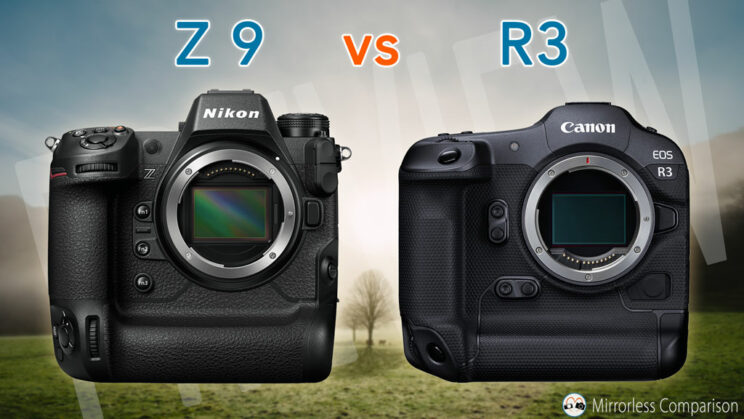
More comparison previews:
Canon R3 vs Sony A1
Nikon Z9 vs Sony A1
Nikon Z9 vs Canon R3
Ethics statement: the following is based on official specifications and early third-party reviews of the two cameras. We were not asked to write anything about these products, nor were we provided with any sort of compensation. Within the article, there are affiliate links. If you buy something after clicking the link, we will receive a small commission. To know more about our ethics, you can visit our full disclosure page. Thank you!
1. Bye bye, mechanical shutter!
The Nikon Z9 becomes the third mirrorless camera, after the Sigma fp and fp L, to get rid of the mechanical shutter altogether, relying solely on the electronic shutter. It’s a brave move and shows the company is confident that its newly developed stacked sensor has the fastest readout time in the world, which makes the mechanical curtains redundant (it also means there is no shutter cycle expiring date to worry about).
I always thought a full time electronic shutter would be the next evolution in mirrorless cameras but I’ll be honest, I didn’t think it would came from Nikon first. Well done! There is also the option in the camera to have it completely silent, or to add a fake shutter sound.
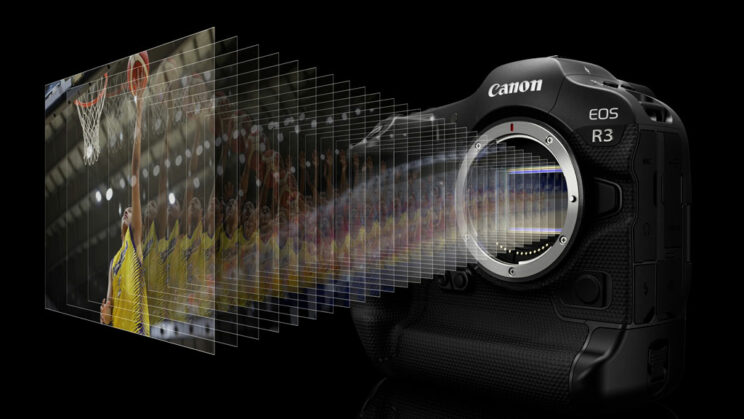
Canon kept both the mechanical and electronic options for the R3, and the electronic version on the EOS model is also very capable. Below you can see the main benefits of using the electronic shutter on both cameras.
| E-shutter | Z9 | R3 |
|---|---|---|
| Max. shutter speed | 1/32,000s | 1/64,000s |
| Max. flash sync | 1/250s | 1/180s |
| Max. drive speed | 20fps 30fps (JPG) 120fps (11MP) | 30fps (RAW/JPG) |
The continuous shooting speeds are all available with AF and AE tracking on both cameras, and they work with live view and no blackouts, which means you’re seeing your subject live in the EVF while shooting, without any interruptions or lag (like the Sony A9 and A1 series).
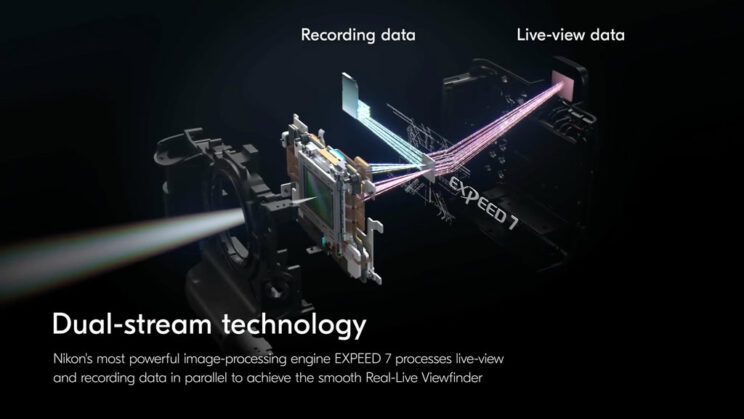
Note that with the R3, the flash sync speed is a bit faster with the mechanical shutter: 1/200s (or 1/250s with the electronic first-curtain shutter).
Both Canon and Nikon claim no distortion when using the e-shutter (rolling shutter effect). This will be especially important for Z9 users because, if there were ever a problem, they wouldn’t have any other option. But given the user target of this camera, I’m sure Nikon made extensive tests in all sorts of situations and light conditions.
Concerning the buffer memory, the Z9 can save more than 1,000 images (JPG or High Efficiency compressed RAW) when recording at 20fps. I couldn’t find information about 30fps.
The Canon can save 540 JPGs or 150 RAW files at full speed when working at 30fps.
2. Sensor: 45MP vs 24MP
The Z9 and R3 incorporate full frame sensors with a stacked design, which allows both cameras to achieve very fast performance when it comes to sensor readout, continuous shooting speeds (as seen in the first chapter above), video frame rates and more. Additionally, the Canon sensor has a BSI structure (back-illumination).
The first difference we find concerns the resolution: the Z9 sensor has 45.7MP whereas the R3 uses 24.1MP.
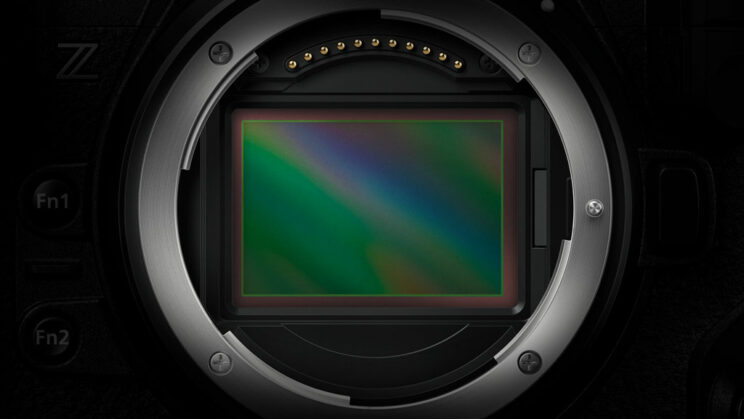
Concerning the sensitivity range, fewer pixels on the R3 make for a wider ISO range. You can also note that the Nikon maintains almost the same range for stills and videos (unlike the Canon), starting from a normal base range of ISO 64.
| ISO | Z9 | R3 |
|---|---|---|
| Photos (normal) | 64-25,600 | 100-102,400 |
| Photos (extended) | 32-102,400 | 50-204,800 |
| Video (normal) | 64-25,600 | 100-25600 |
| Video (extended) | 64-102,400 | 100-102,400 |
The Z9 can record 14-bit RAW files with lossless compressed or the new High Efficiency option. The latter reduces the file size by half or two thirds, so that the camera can process a larger quantity of files more quickly.
The R3 can record with lossless RAW or compressed RAW (14-bit).
3. Machine learning autofocus
Both cameras feature the most advanced autofocus designed by the two companies respectively, and they rely on powerful algorithms and machine learning to recognise different types of subjects.
The Z9 uses 493 hybrid (contrast / phase) detection points and a very fast processing speed with 120 calculations per second (like the Sony A1).
The R3 uses the Dual Pixel CMOS AF II system with 1,053 areas and 60 calculations per second.
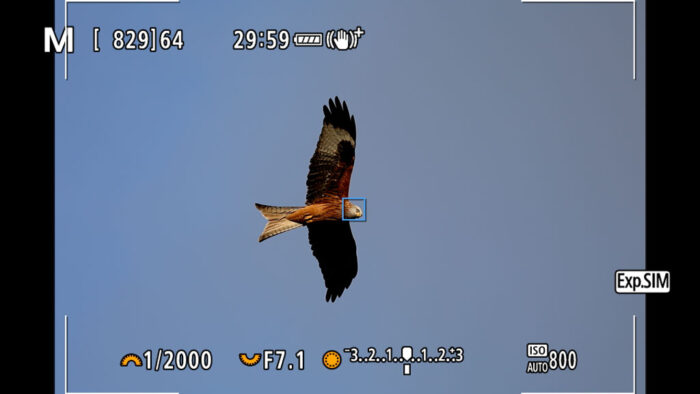
Both cameras can detect a variety of subjects and focus on different parts of the body, such as eyes for humans or animals, or helmets for racing cars. Here is the range of subjects they can track specifically. Note that the Z9 can detect any of these subjects automatically, whereas on the R3 you need to specify which one in the menu.
| Subject det. | Z9 | R3 |
|---|---|---|
| Humans | Eyes, faces, torsos | Eyes, faces, torsos |
| Animals | Dogs, cats, birds | Various (including birds) |
| Vehicles | Cars, bikes planes, trains | Cars and bikes |

Nikon has also implemented 3D Tracking, its advanced tracking system that is very well known among DSLR users. It is the first time that this method is present on a Z-mount mirrorless camera.
The Z9 has a minimum sensitivity in low light of -6.5Ev, measured with an F1.2 lens. With the Startlight View assist, the rating goes down to -8.5Ev.
The R3 is one stop more efficient, with -7.5Ev, also measured at f/1.2.
4. 8K vs 6K video
The Nikon Z9 can record 8K video internally up to 30p. It offers a variety of codecs, including Apple Prores 422 HQ. This is the first mirrorless camera that can record with the popular professional Apple codec. But that is not all. The Z9 can also do 4K up to 120p. A future firmware will bring 8K 60p and 8K RAW internally.
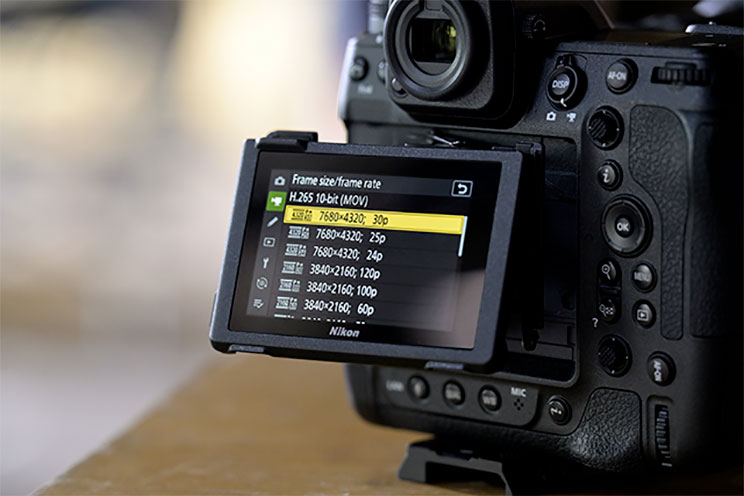
The Canon R3 may not reach 8K resolution, but its video capabilities are spectacular nonetheless, with 6K and 12-bit RAW available for internal recording.
There is no sensor crop on either camera, and no 30 minute recording limitation either.
Here is a recap of all the main specs:
| Format | Z9 | R3 |
|---|---|---|
| 8K 60/30p | yes* | – |
| 6K 60/30p | – | yes |
| 4K 120/60/30p | yes | yes |
| FHD 120/60/30p | yes | yes |
| Codecs | ProRes 422 HQ* H.265/HEVC H.264/AVC | H.265/HEVC H.264/AVC ALL-I |
| Bit depth | 10-bit / 8-bit | 10-bit / 8-bit |
| Max. bitrate | n.a. | 2600Mbps |
| RAW | 12-bit* | 12-bit |
| Log / HDR | Yes | Yes |
Up to 30p, the Z9 does over-sampling, meaning it uses the 8K region to create the 4K footage, which enables superb details and sharpness. At 60p and 120p however, it’s not oversampling (but Nikon hasn’t mentioned if it is pixel binning or line-skipping).
The R3 does oversampling in 6K and 4K up to 60p.
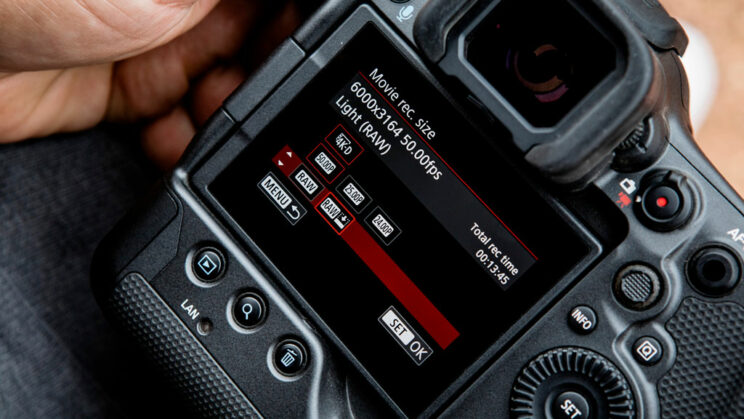
5. In-body stabilisation
Both cameras feature 5-axis image stabilisation on the sensor. The Z9 reaches a compensation rating of 6Ev when using Z lenses with VR (optical stabilisation).
The R3 has a higher compensation rating of 8Ev, although keep in mind that the rating is not the same for all lenses.

The 5-axis system can combine sensor and optical stabilisation, and is also valid during movie recording. Additionally, you add digital stabilisation (video only) to improve the result, although keep in mind that a small crop is applied. Canon calls this Digital IS, Nikon calls it Electronic VR.
The Z9 also locks the IBIS mechanism when the camera is turned off to avoid it being shaken if, for example, the body is on the rear seat of a car traveling on a bumpy road.
6. Viewfinder and monitors
The Z9 features an electronic viewfinder with 3.69M dots of resolution, which is not an impressive number considering that other competitors have 5M or even 9M dots. However Nikon claims that it is the brightest EVF on the market with 3000-nit. The magnification is 0.8x with a 60Hz refresh rate and a 23mm eye-point.
The R3 viewfinder has more resolution with 5.76M dots, but a slightly smaller magnification of 0.76x. The eye-point has the same length (23mm) but the refresh rate goes up to 120Hz.
All this said, the R3 has a unique feature you won’t find anywhere else: Eye Control AF. Inside the EVF there are 8 infrared sensors that read the position of your eyeball, and move the AF point or switch tracking from one subject to another simply by following the movement of your eye. In simple words, you can focus on a subject by simply looking at it.
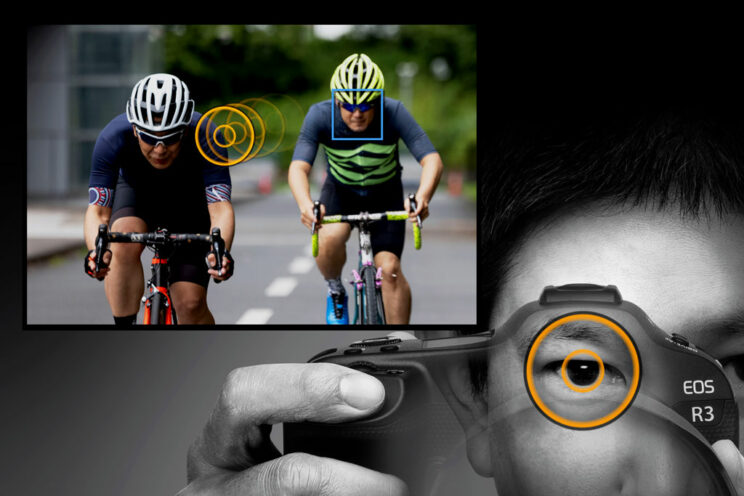
As for the rear monitors, both cameras have a 3.2-in (8cm) LCD with touch sensitivity. The R3 features a superb 4.15M dots of resolution, which is double that of the Z9 (2.1M dots).
The moving mechanism is also different: that of the Nikon works on 4 axes, meaning you can also tilt it up and down when you work in portrait mode (vertical orientation). On the R3, you have the classic multi-angle movement, which means you can flip it 180˚.
Finally, both cameras have an extra monitor on top that displays the basic settings in use.
7. Design tidbits
The Z9 and the R3 are very robust cameras, with weather sealing and a magnesium alloy frame. The dimensions are very similar, but the Nikon is heavier.
- Z9: 149 x 149.5 x 90.5mm, 1340g
- R3: 150 x 142.6 x 87.2mm, 1015kg


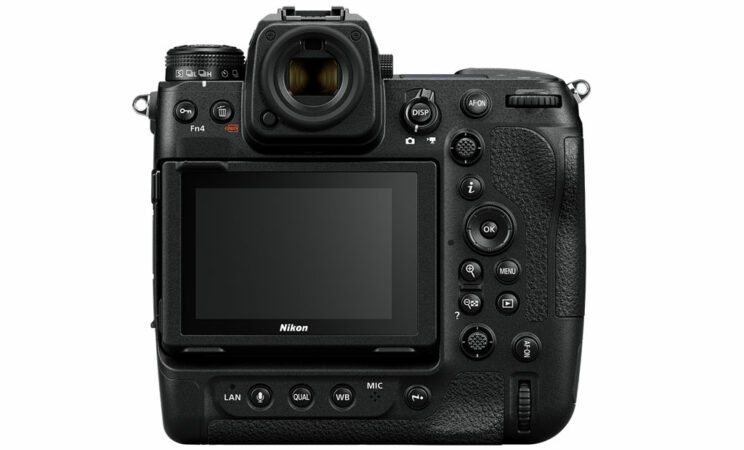
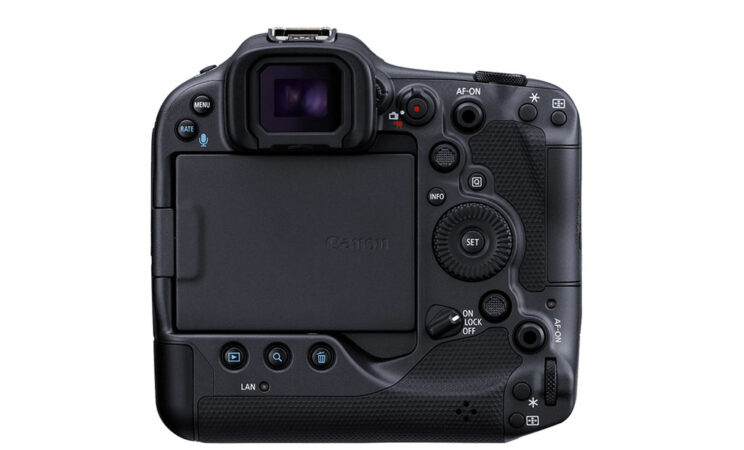
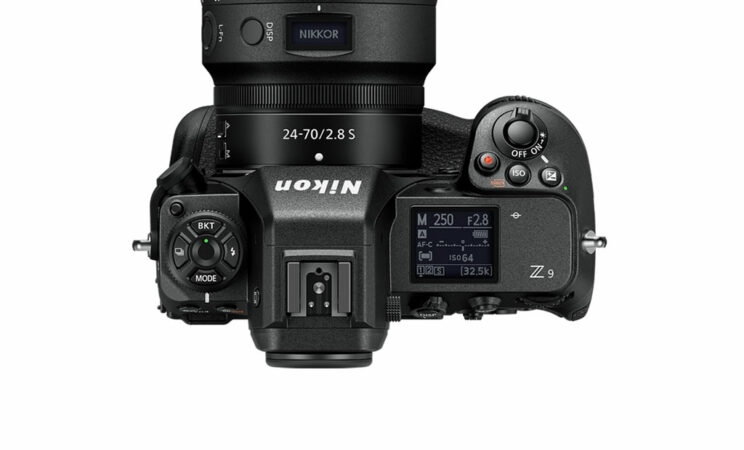
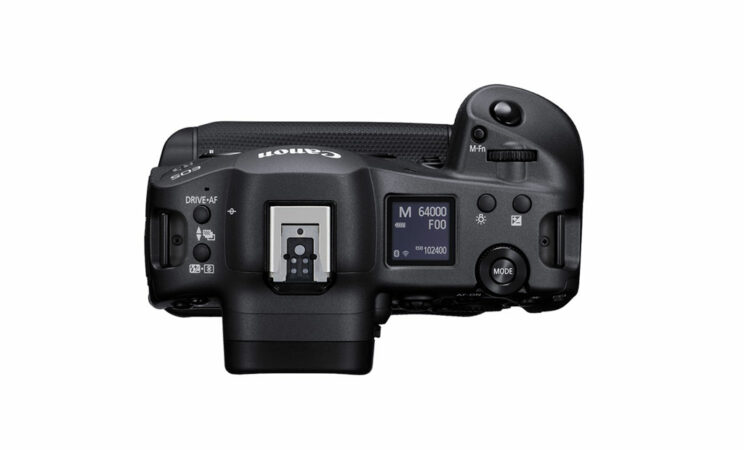
Each cameras has its own button layout and controls. Things worth highlighting are the smart controller on the rear of the R3 (a ‘touchpad’ alternative to the normal AF joystick, which is also present). Most of the buttons on the Z9 are backlit.
Both cameras can cover the sensor when powered off to protect it. While the R3 uses the curtains of the mechanical shutter, the Z9 has a mechanism design only for this purpose, which should also be more robust.
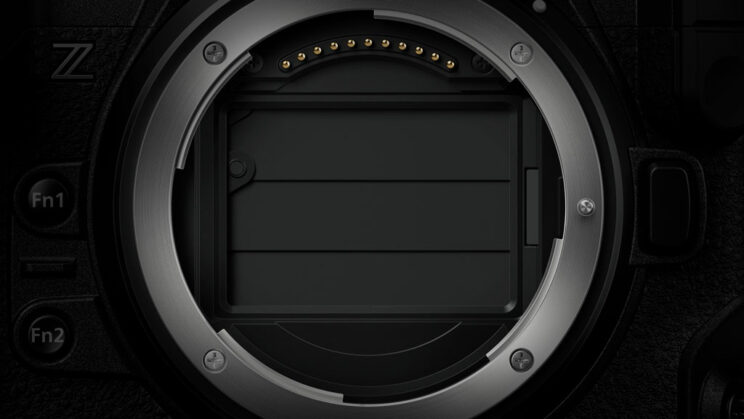
8. Cards, interface and battery life
The Z9 works with two cards, and they are both the CFexpress Type B standard.
The R3 also has two slots, but one for CFexpress cards and one for SD UHS-II cards.
Both cameras have a LAN / Ethernet port, USB Type C, microphone input, headphone output and a full size HDMI socket.
The battery life is similar for both cameras: the Nikon can do 740 frames with the LCD, or 700 with the EVF. The Canon does better with the LCD (860) but worse with the viewfinder (620).
9. Lenses
Both systems started in 2018 and today they have a good selection of native lenses to offer alongside the camera bodies.
Nikon has 19 full frame lenses, with the 100-400mm F4.5-5.6 launched alongside the Z9 (the longest telephoto lens at the moment), plus two teleconverters. There are high quality F2.8 zooms and super fast primes among other things.
Canon has 23 RF lenses going at the moment, including very fast F1.2 primes, the F2.8 trinity zoom and more super telephoto offerings than Nikon, as well as two focal extenders.
In both cases, you can use Canon EF and Nikon F DSLR lenses with an adapter, and both companies have made one. Nikon has also released the mark II version of its FTZ adapter. The performance when it comes to autofocus remains really good.
10. Price
The Z9 was launched at the retail price of $5500 / £5300 / €6000 for the body only, which makes it less expensive than the Canon model in some countries.
The R3 can be found for $6000, £5880 or €6000 (body only).
Prices as of late October 2021.
Conclusion
The Z9 and the R3 are two important cameras for their respective brands. After years of lagging behind their mirrorless competitors (Sony in particular) in terms of important innovations such as autofocus, stacked sensors and the electronic shutter, the two flagship cameras finally prove that Canon and Nikon are back in the game.
The Z9 in particular impresses me because Nikon has dared to go further than any other brand when it comes to video (internal 8K RAW) and shutter technology (by removing the mechanical curtains altogether), a move that neither Canon or Sony have made yet.
That said, the Z9 is not in a class of its own. The R3 is as capableas its counterpart in every way except the sensor resolution (24MP vs 45MP) and video (6K vs 8K), while also housing a few unique features of its own like the Eye Control AF.
And of course we mustn’t forget Sony, the brand that started the electronic shutter evolution with a 20fps drive speed and blackout-free EVF with the A9 in 2017, four years before Canon and Nikon, and has in the recent A1 a very strong competitor. High-end mirrorless cameras have never looked better than this.
Reminder: the links below are affiliate links. If you decided to buy something after clicking the link, we will receive a small commission.
Check price of the Nikon Z9 on
B&H Photo
Check price of the Canon Eos R3 on
B&H Photo
More comparison previews:
Canon R3 vs Sony A1
Nikon Z9 vs Sony A1
Nikon Z9 vs Canon R3
